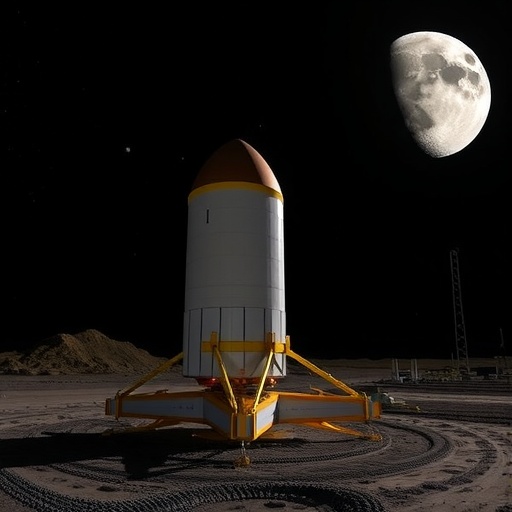In the realm of space exploration, advancements in technology are pivotal in addressing the challenges of long-duration missions beyond Earth. In a recent development, researchers from The University of Texas at San Antonio (UTSA) and the Southwest Research Institute (SwRI) are set to flight test an innovative electrolyzer designed to enhance our understanding of chemical processes in low gravity environments. This project, which has garnered a substantial grant of $125,000 from the Connecting through Research Partnerships (Connect) program, aims to unravel the complexities associated with bubble formation and fluid dynamics in partial gravity settings, specifically conditions analogous to those found on the Moon and Mars.
The significance of this research lies in its potential applications for in situ resource utilization (ISRU) during space missions. As the push for sustainable human exploration of celestial bodies intensifies, the necessity to create essential chemicals and consumables from local resources becomes apparent. Kevin Supak, a key figure in this research project, elaborates that extended missions will necessitate effective systems capable of extracting and producing vital resources for astronauts. A noteworthy aspect of the project is that it combines expertise from both institutions, facilitating collaboration that enhances scientific endeavors in the sphere of space technology.
One of the primary focuses of this flight test will be the patented electrolyzer known as the Mars Atmospheric Reactor for Synthesis of Consumables (MARS-C). This advanced system is engineered to utilize local raw materials, specifically Martian brine and carbon dioxide, to generate methane and oxygen—crucial components for life support during human habitation on other planets. The integration of MARS-C into a flight rig developed by SwRI represents a significant leap in understanding how such systems might operate under the unique gravitational conditions that exist on celestial bodies.
In its operational design, the MARS-C electrolyzer deploys voltage across two electrodes, triggering electrochemical conversions that mimic essential processes required for sustaining life. The electrolysis will replicate the conditions of Martian brine, a liquid that, despite its harsh environment, may potentially harbor vital resources for human survival. This simulated environment will enable researchers to observe and analyze the interactions of gases and liquids, particularly focusing on bubble dynamics and how they are influenced by reduced buoyancy conditions.
Our understanding of fluid dynamics under partial gravity is still evolving, particularly the behavior of gas bubbles that can alter efficiency and output in electrolyzers. Understanding how these bubbles nucleate—how and when they form within the liquid medium—is critical, as such dynamics can significantly impact the overall performance and reliability of resource production systems. As Supak pointed out, the reduced buoyancy in environments like Mars presents unique challenges for keeping surfaces wetted, which is a prerequisite for the electrolyzer to function correctly.
Flight tests aboard parabolic aircraft, which create brief periods of freefall to simulate microgravity, are pivotal in this research. Previous studies conducted by SwRI demonstrated the significant effects of lowered gravity on bubble dynamics, revealing crucial insights into how these systems operate. By conducting further tests in these controlled conditions, researchers will be poised to gather essential data on how gas production rates vary under different gravitational stresses, thus refining our approach to designing equipment for extraterrestrial environments.
The granted Connect funding allows the research team to expand their testing parameters considerably. It opens avenues to examine not only the electrochemical processes involved but also the influence of environmental variables akin to those found on the Moon and Mars, including varying temperature conditions that will directly affect the chemistry within the electrolyzer. Such comprehensive testing is vital for making informed decisions regarding technology development pertinent to future space missions.
Advanced instrumentation will also play a crucial role in this research, particularly high-speed cameras that will document the bubble formation process in real-time. By utilizing these tools during the parabolic flights, researchers can develop a nuanced understanding of the onset of bubble nucleation and its evolution within the electrolyzer cells. This real-time analysis promises to yield insights that could reshape our existing models surrounding gas-liquid interactions in low-gravity environments.
The research project is not solely about academic curiosity; it aims to ensure that humanity can effectively establish a presence on other planets. Both Supak and Sankarasubramanian have collaborated with NASA on this research and were honored with the TechLeap prize earlier this year for their work related to flight testing this innovative electrolyzer technology. Such recognition highlights the critical importance of this research within the broader context of space exploration and human habitation.
Ultimately, establishing sustainable practices for chemical production in outer space is more than a scientific challenge; it’s a necessity for the future of human exploration. As noted by Sankarasubramanian, this initiative also aims to enhance NASA’s Technology Readiness Level (TRL) for such technologies, bridging the gap between theoretical science and practical application in extraterrestrial environments. The ability to generate fuel, oxygen, and other life-sustaining materials from Martian resources could potentially alter humanity’s timeline for becoming a multi-planetary species.
In conclusion, the collaborative efforts between SwRI and UTSA represent a significant stride in addressing technical hurdles that accompany space exploration. By employing innovative research methodologies and cutting-edge technology, these institutions are making strides toward sustainable human presence on celestial bodies. The outcomes of the upcoming flight tests will undoubtedly contribute to the broader understanding of fluid dynamics and resource production systems in space, paving the way for future missions to the Moon, Mars, and beyond.
Subject of Research: Electrolyzer technology for in situ resource utilization in low gravity
Article Title: Testing Electrolyzer Technology for Space Resource Utilization
News Publication Date: September 17, 2025
Web References: Southwest Research Institute
References: N/A
Image Credits: Southwest Research Institute/UTSA




